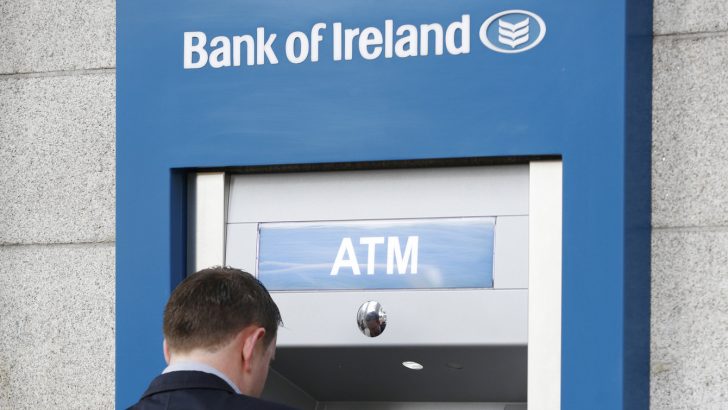When my brother James went to work in a bank, he was first sent to Oldcastle, Co. Meath. In those days – this was back in the 1950s – the Hibernian Bank was regarded as ‘the Catholic bank’, especially in counties nearing the border, while the Ulster Bank was regarded as ‘the Protestant bank’.
Farmers
James was surprised to discover, however, that so many of the local Protestant farmers kept their funds in the Hibernian, while a goodly number of the Catholic farmers did business at the Ulster Bank. He soon figured out that the shrewd farming folk thought their financial affairs would remain more private if sequestered in a bank associated with a different Christian denomination from their own kinfolk. There’d be less likelihood of loose talk around the golf links on the lines of “You’d be surprised how much old O’Reilly has on deposit”. Perish the thought that a banker would ever be indiscreet enough to drop such a hint, but the suspicion might have been there.
In any case, bank relations were cordial, even if competitive. On one St Patrick’s Day, the Ulster Bank ran the tricolour up the flagpole, and the Hibernian had to, somewhat hurriedly, match their rivals. But the Ulster Bank then produced a trump: they then ran the Papal flag up the flagpole, a masterstroke which the Hibernian found itself unable to match.
Community
These were the days when banks, and bankers, were respected and indeed trusted elements of the community, notwithstanding some of the farmers’ concerns for financial secrecy. My brother found himself, eventually, in Dublin’s College Green where he became a secular pastor, with a line of people always waiting to talk to him about their woes, financial and otherwise, and he gave them his time, and his best counsel.
88 branches of the Bank of Ireland alone, from Tullow to Cootehill, from Kilkee to Youghal, from Bundoran to Oughterard, from Kiltimagh to Kinnegad”
There were many bank officials, and bank managers, like him: helpful, kind, approachable, and giving good advice about money-related issues. I myself had a very supportive bank manager, Colette O’Neill at AIB, who sorted me out so constructively with the mess I had got myself into over credit and store cards (at one stage I had twelve – all accruing interest).
But it’s goodbye to all that, now, as bank branches all over Ireland close down: 88 branches of the Bank of Ireland alone, from Tullow to Cootehill, from Kilkee to Youghal, from Bundoran to Oughterard, from Kiltimagh to Kinnegad. AIB is also combining some of its branches and the Ulster Bank is to withdraw entirely from the south from next year.
Apart from the vexation – and even danger – to traders who will need to travel long distances to lodge cash, there is a huge loss of the human dimension and the need for people to talk to people, face to face, to seek advice, assistance and expertise from those with whom their earnings have been entrusted. Computerised transactions can never, ever replace that human touch, let alone the presence on so many main streets of what was once a service to the community.
***
Jonathan Roche of the University of Nottingham has discovered that a Welsh Catholic spy, Hugh Owen, played a leading role in sending at least one Spanish Armada to Elizabethan England. The historian has found Mr Owen’s reports in the Spanish archives: the Welshman was assisted by a double agent working for the Earl of Essex and a network which included several Jesuits.
Mr Owen’s motive was to bring England back to Catholicism, and the information sent to Spain led to the deployment of the third Spanish Armada of 1597. If it hadn’t been for a storm off the Scilly Isles, Spain might have conquered. One of the great ‘ifs’ of history!
***
The spiritual wealth of secular France
France, as we know, is most insistent on being a secular republic – religious images or statues are forbidden on state or municipal property. And yet, France is proud of its Catholic heritage, in cathedrals, saints, abbeys and monasteries. I saw a wonderful programme on French television last Sunday about the extraordinary spiritual wealth of the monasteries, identifying most especially Mont St Michel and Cluny. And identifying most especially, too, St Bernard of Clairvaux, who started the Cistercian order, and whose preaching and eloquent writing inspired so many young men to commit to the monastic life.
Bernard, who died in 1153, was known for his austerities, so he is particularly suited to being a Lenten saint. He is also the focus of many great paintings, including works by Pier Francesco Foschi and Filippino Leppi, both now in Florence. Giovanni Benedetto Castiglione’s The Crucified Christ embraces St Bernard hangs in a church in Genoa.
Bernard’s name in origin means ‘strong bear’ which made me wonder if the gentle, bear-like canine breed is named after him, but it seems the St Bernard dog is named after the St Bernard pass between Switzerland and Italy.


 Mary Kenny
Mary Kenny
